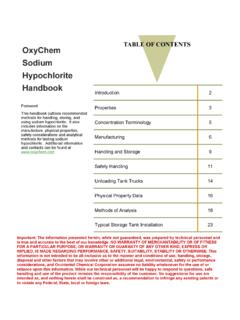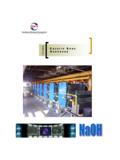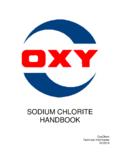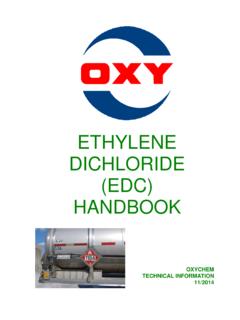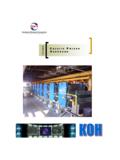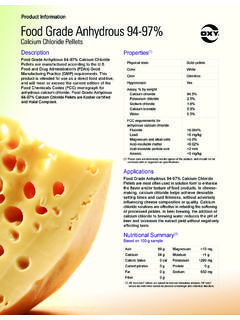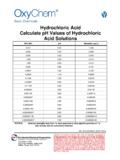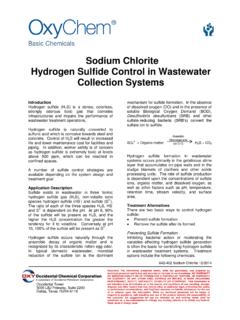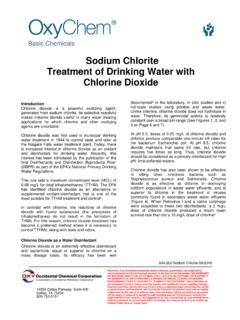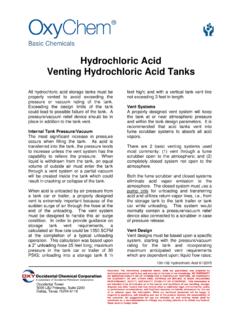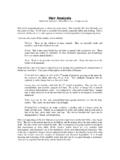Transcription of Hydrochloric Acid Handbook - Occidental Petroleum
1 Hydrochloric acid Handbook OxyChem . OxyChem is a registered trademark of Occidental Chemical Corporation 06/2013. Dallas-based Occidental Chemical Corporation is a leading North American manufacturer of basic chemicals, vinyls and performance chemicals directly and through various affiliates (collectively, OxyChem). OxyChem is also North America's largest producer of sodium chlorite. As a Responsible Care company, OxyChem's global commitment to safety and the environment goes well beyond compliance. OxyChem's Health, Environment and Safety philosophy is a positive motivational force for our employees, and helps create a strong culture for protecting human health and the environment. Our risk management programs and methods have been, and continue to be, recognized as some of the industry's best. OxyChem offers an effective combination of industry expertise, experience, on line business tools, quality products and exceptional customer service. As a member of the Occidental Petroleum Corporation family, OxyChem represents a rich history of experience, top-notch business acumen, and sound, ethical business practices.
2 Table of Contents Page INTRODUCTION TO Hydrochloric acid .. 1. MANUFACTURING .. 2. Hydrochloric acid USES .. 3. SPECIFICATIONS AND PRODUCT 4. SAFETY AND FIRST AID .. 5. HAZARDS .. 5. SAFETY PRECAUTIONS .. 7. FIRST AID .. 7. 9. SPILL REPORTING .. 9. HAZARDOUS CHEMICAL STORAGE REPORTING .. 9. SECTION 313 TOXIC CHEMICAL RELEASE INVENTORY METHODS OF HANDLING AND STORAGE ..11. STORAGE TANK VENTING AND Hydrochloric acid FUME Storage Tank Venting ..12. Hydrochloric acid Fume Scrubbers ..13. EQUIPMENT SOURCES ..15. UNLOADING Hydrochloric acid FROM TRANSPORTATION Unloading Hydrochloric acid Tank Cars ..19. Unloading Procedures for Tank Cars ..23. UNLOADING BY PUMP ..24. Unloading Hydrochloric acid Tank Trailers ..26. Unloading Procedures for Tank Trailers ..27. SPILLS AND NEUTRALIZATION ..30. TECHNICAL DATA ..31. BILLING PROCEDURE ..31. DILUTION OF Hydrochloric acid ..31. METHODS OF ANALYSIS ..42. SAMPLING ..42. DETERMINATION OF TOTAL DETERMINATION OF GRAVITY ..43. DETERMINATION OF IRON.
3 44. DETERMINATION OF COLOR ..45. FURTHER INFORMATION ..46. REFERENCES ..46. Introduction to Hydrochloric acid 1. Manufacturing OxyChem produces its Hydrochloric acid by combining hydrogen and chlorine in " acid burners". The resulting Hydrochloric acid , also known as muriatic acid , is an hydrogen chloride gas is then absorbed in de- aqueous solution of hydrogen chloride gas. mineralized water to yield a high purity Hydrochloric Hydrochloric acid is produced in the United States acid . OxyChem also markets Hydrochloric acid primarily by four basic methods: the chlorination of produced by a number of other manufacturers. This organic chemicals; the combination of hydrogen and material is a co-product from the production of other chlorine; the salt-sulfuric acid production process; and, chemicals. as a co-product in the manufacture of silica. Most Hydrochloric acid is produced from the chlorination of organic chemicals with much smaller amounts from the other processes. OxyChem Production of Hydrochloric acid Drying Liquifaction Heater Chlorine Chlorine Outlet Demineralized Water Brine Feed Purifier Hydrogen HCl Gas acid HCl Burner Absorber Storage 22 B acid Tank Sodium Carbonate Brine Sodium Caustic (Cell Electrolytic Cell Hydroxide Liquor) Outlet 2.
4 Hydrochloric acid Uses Hydrochloric acid is an important and widely used chemical. The largest end uses for Hydrochloric acid are steel pickling, oil well acidizing, food manufacturing, producing calcium chloride, and ore processing. Steel pickling Hydrochloric acid is used in pickling operations for carbon, alloy and stainless steels. Steel pickling is the process by which iron oxides and scale are removed from the surface of steel by converting the oxides to soluble compounds. Pickling is required for steel products that undergo further processing such as wire production, coating of sheet and strip, and tin mill Other food uses products. Hydrochloric acid is used primarily for continuous pickling operations in which hot-rolled strip Hydrochloric acid is also used in other food processing steel is passed through a countercurrent flow of acid applications including the production of hydrolyzed solution. vegetable protein and soy sauce. It is used in acidulating crushed bones for the manufacture of In addition to steel pickling, Hydrochloric acid is used in gelatin and as an acidifier for products such as sauces, aluminum etching, metal prefixing for galvanizing and vegetable juices and canned goods.
5 Soldering, and metal cleaning. Hydrochloric acid is also consumed in the production of Oil well acidizing artificial sweeteners and in the production of lysine, Hydrochloric acid is used both to remove rust, scale choline chloride (both used primarily as animal feed and undesirable carbonate deposits in oil wells to additives) and citric acid . encourage the flow of crude oil or gas to the well. This use is called "stimulation." Acidizing is generally done Production of Calcium Chloride in carbonate or limestone formations by stimulation. Neutralizing Hydrochloric acid with limestone (CaCO3). An acid solution is injected into the formation, which produces calcium chloride. The largest use for calcium dissolves a portion of the rock and creates a large pore chloride is highway deicing with production dependent structure in the formation, increasing its effective on weather conditions. Other uses include dust permeability and the flow of oil. control, industrial processing, oil recovery, concrete treatment and tire ballasting.
6 Calcium chloride is also Food used in oil recovery products such as drilling muds and The food industry uses Hydrochloric acid in the work over/completion fluids. processing of a variety of products. A major use of Hydrochloric acid by the food industry is for the Ore Processing production of corn syrups such as high-fructose corn Hydrochloric acid is consumed in many mining syrup (HFCS). operations for ore treatment, extraction, separation, purification and water treatment. Significant quantities Much of the Hydrochloric acid consumed in the HFCS are used in the recovery of molybdenum and gold. industry is used to regenerate the ion exchange resins Hydrochloric acid is used to convert high-grade that are employed to remove impurities. Hydrochloric scheelite concentrate (CaWO4) and crude sodium acid can also be used to acid -modify cornstarch and to tungstate to tungstic acid , which in turn, can be used to adjust the pH of intermediates, final product and produce tungsten metal and chemicals.
7 Hydrochloric wastewater. The largest use of HFCS is in the acid is also used in uranium and zirconium processing, production of soft drinks, which accounts for 70-75% of solution mining of borate ores, as a pH regulator in the demand. froth flotation of potash ores, and in rare earth extraction from bastnasite. 3. Hydrochloric acid Uses (continued). Specifications and Product Grades Other OxyChem produces and markets Technical Grade Hydrochloric acid in two concentrations: 22 Baum . Aqueous Hydrochloric acid is used in a variety of ( HCl by wt.) and 20 Baum ( HCl by miscellaneous applications. These include recovery of wt.). Other dilute concentrations of Hydrochloric acid semiprecious metals from used catalysts, use as a may be available upon request catalyst in synthesis, use in catalyst regeneration, pH. control, regeneration of ion exchange resins used in The Technical Grade acid meets the testing wastewater treatment and electric utilities, requirements of Food Chemicals Codex as well as neutralization of alkaline products or waste materials, ASTM Standard E 1146.
8 Material produced and and in brine acidification for use in the production of shipped from OxyChem's Wichita plant is Star-K. chlorine and caustic soda. Kosher certified and is certified by NSF under ANSI/NSF Standard 60 Drinking Water Treatment Hydrochloric acid is also used in many other production Chemicals. The manufacturing process for Technical processes for organic chemicals. It can be used in the Grade Hydrochloric acid does not incorporate all of the production of p-phenylenediamine, polycarbonate measures specified in the Food and Drug resins, bisphenol A, polyvinyl chloride resins, and Administration's current Good Manufacturing Practices ethanol (from ethylene). (cGMP). It is the responsibility of the user to assess their use of Technical Grade Hydrochloric acid The pharmaceutical industry consumes Hydrochloric products in food, feed, or pharmaceutical related acid as a catalyst in synthesis, for pH control, for applications and to determine whether appropriate deionization of water and as a reduction agent ( , in regulatory requirements are being met.)
9 The production of ascorbic acid and para-aminobenzoic acid ). OxyChem's Technical Services Department can provide product information for each grade of Numerous other uses of Hydrochloric acid include the Hydrochloric acid . Call or write: manufacture of dyes and pigments; the removal of Technical Services Department sludge and scale from industrial equipment; the OxyChem deliming, tanning and dyeing of hides by the leather Box 12283, Wichita, KS 67277-2283. industry; manufacture of permanent wave lotion; the Phone: 800-733-1165, option #1. carbonizing of wool; use as a bleaching and dyeing assistant in the textile industry; and the purification of sand and clay. t Aid 4. Safety and First Aid Hazards PROTECTIVE CLOTHING. Hydrochloric acid is a highly corrosive and hazardous chemical and should be handled with extreme care. Personnel should be properly trained in the handling of Face Shield Hydrochloric acid and should always wear the proper Splash Proof Goggles protective equipment when working around Hydrochloric acid .
10 All users should read the Material Safety Data Sheet (MSDS) before handling Hydrochloric acid . Protective Clothing Hydrochloric acid is very corrosive to the skin and Escape Respirator mucous membranes and can cause severe burns to any part of the body. The corneas of the eyes are especially sensitive to Hydrochloric acid and exposure to it or its vapors immediately causes severe irritation. If the eyes are not quickly and thoroughly irrigated with water, partial or total visual impairment or blindness can occur. It is recommended that employees be provided with and required to use acid impervious clothing, gloves, boots, splash proof goggles and other appropriate protective clothing necessary to prevent any possibility of skin contact with hydrogen chloride mists or solutions. Material types which may be considered for this service include nitrile, neoprene, polyvinyl chloride (PVC), butyl rubber, Responder , Trellchem , and Tychem . Face shields should also be provided when there is a chance of splashing liquid Hydrochloric acid .
